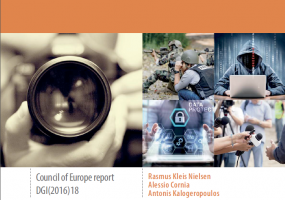Research: How Public Service News uses Social Media

Public service media organisations across Europe are investing in dedicated social media teams who strategically use platforms, such as Facebook, Twitter and Instagram, to deliver news to younger and hard-to-reach audiences. While recognising the usefulness of social media, many also see a tension between their organisation’s public service values and the commercial objectives of social media companies.
New research, by Annika Sehl, Alessio Cornia and Rasmus Kleis Nielsen, of the Reuters Institute for the Study of Journalism, examines how public service media (PSM) in six European countries (Finland, France, Germany, Italy, Poland, and the United Kingdom) deliver news via social media.
All of the organisations studied consider engagement metrics important, but say metrics do not influence editorial policy.
Facebook is viewed by PSM social media strategists as an effective way to reach large online audiences; Twitter is used to target a smaller audience of news lovers and as a ‘news ticker’, Instagram is used to offer more visual content targeted at young people and female audiences.
Findings:
- Public service media consider social media to be an important way to reach young and hard-to-reach audiences with news.
- Many organisations originally expected journalists to engage with social media as part of their daily routines, but all have now set up dedicated social media teams.
- The size of social media teams for news varies, but in all cases the teams are small compared to the overall size of the organisations’ newsroom(s).
- Public service media organisations are consolidating their social media outreach, reducing their number of accounts on various platforms to concentrate their efforts.
- Public service media have three main goals for distributing their news on social media: generating traffic via referrals to their own websites, reaching younger and hard-to-reach audiences with native content directly on the social media platforms, and, at least for some, user participation.
- How public service media pursue these goals depend on their main strategic focus. Some focus on using social media to drive referrals to their own websites. Others pursue an off-site strategy primarily aimed at reaching younger and hard-to-reach-audiences directly on various social media platforms with native content.
- Social media metrics that reveal ‘shares’ and ‘likes’ are important to public service media organisations, but they use them only tactically to inform day-to-day decisions and optimise postings, not to determine editorial priorities or dictate long-term strategy.
- All interviewees said they keep abreast of the impact of sometimes sudden algorithm changes made by social media platform companies, but take care to maintain their strategic autonomy.
The study:
The analysis is based on 14 interviews conducted between November 2017 and January 2018, primarily with senior editors and managers for news, or social media for news specifically from organisations including the BBC, YLE, ZDF and RAI. Interviews were complemented with various analyses of how public service media perform on social media. We analyse public service media’s different social media strategies, how they organise their work, and how they adapt tactically to changes in ranking algorithms and products. The social media platforms focused on in this report are Facebook, Twitter, and Instagram.
Dr. Annika Sehl, lead author of the report, says: “We have identified two different strategic approaches of public service media to social media for news: Some public service media pursue an on-site strategy, and primarily aim to use social media to drive referrals to their own news websites. Others pursue an off-site strategy and primarily aim to reach younger and hard-to reach-audiences directly on the social media platforms with native content. Despite these differences in strategic goals, we find that day-to-day tactics of the social media teams are surprisingly similar. This is largely because they are shaped by incentives created by platform companies and by social media teams imitating what they see as best practices elsewhere.”
For more on the report.
Image: Screenshot from Instagram news accounts of ZDF, BBC, YLE. Twitter logo, Flickr CC.



